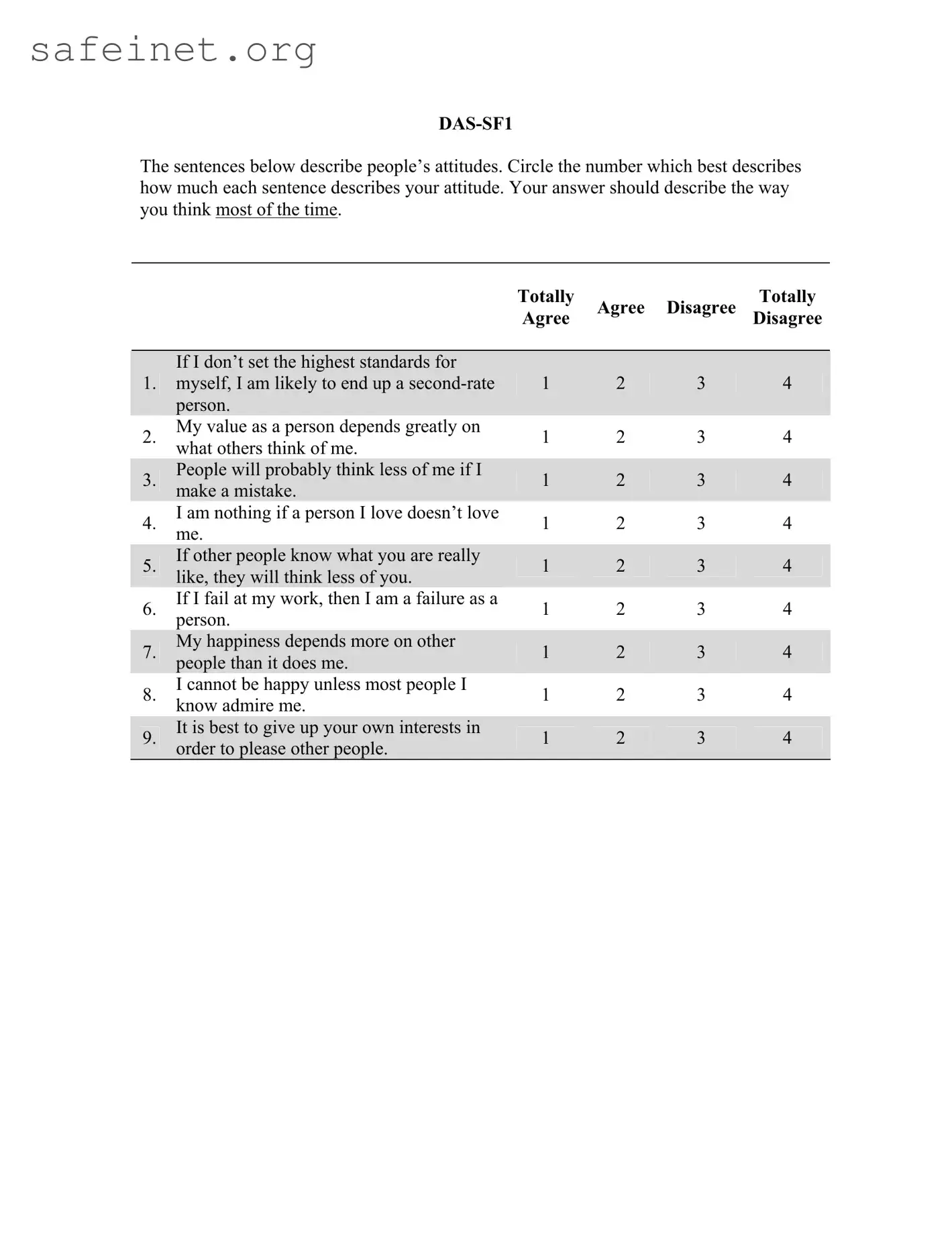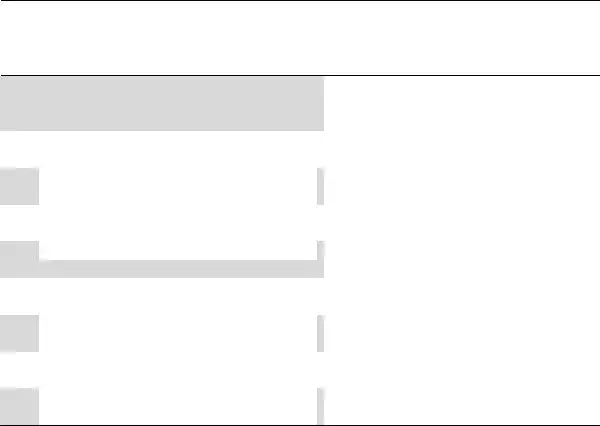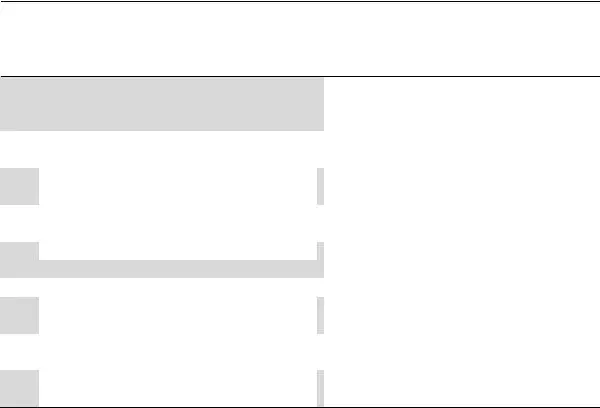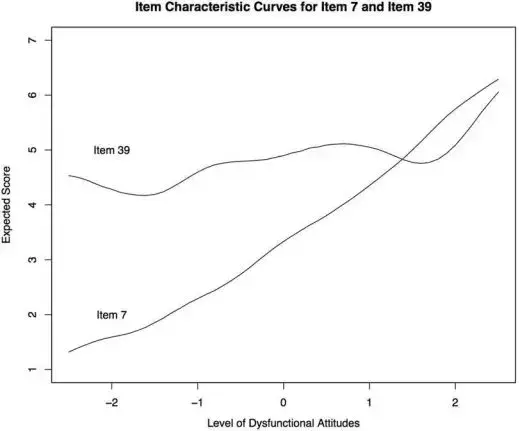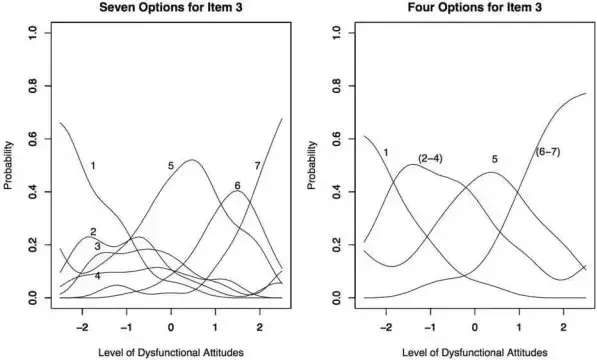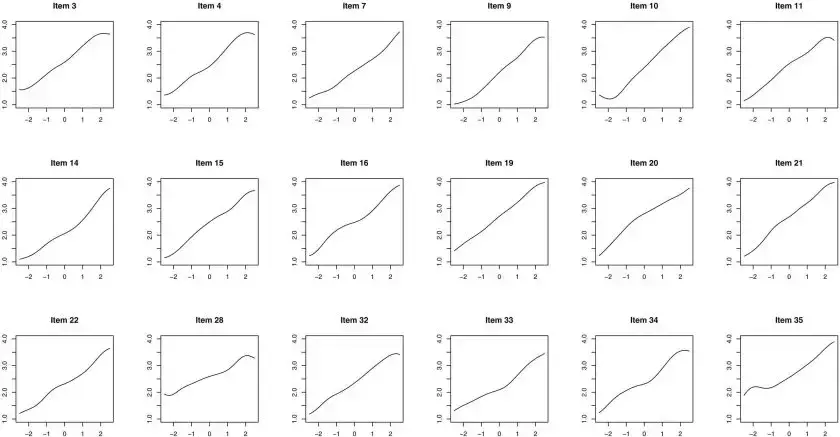originally a 100-item scale and was subsequently refined into two 40-item forms (Versions A and B) based on factor analyses from a student population. Although Beck and colleagues have recom- mended using an 80-item version (Beck, Brown, Steer, & Weiss- man, 1991), the DAS-A is used more frequently. The DAS-A is a self-report questionnaire that measures a variety of rigid, negative, and perfectionist attitudes. Many items also assess dysfunctional contingencies for self-worth (e.g., “If I do not do well all the time, people will not respect me”). Despite the widespread use of the DAS-A, relatively few investigations have examined its psycho- metric properties. Further, no study has used modern analytic techniques, such as item response theory (IRT), to examine the psychometrics of the DAS-A items.
Studies that have investigated the psychometric properties of the DAS-A typically used evaluation methods based on traditional, or classical, test theory (Nunnally, 1979). This approach emphasizes the internal consistency reliability, test–retest reliability, and factor structure of an assessment. Past research suggests that the DAS-A has good internal consistency reliability, test–retest reliability, and replicable factor structure (e.g., Dobson & Breiter, 1983). For instance, using Treatment of Depression Collaborative Research Program (TDCRP) data, Imber et al. (1990) reported that the DAS-A has two related factors: perfectionism and need for ap- proval. These factors had good internal consistency reliability ( .91 and .82, respectively) and were highly correlated (r
.59) with each other. Using structural equation modeling, Zuroff, Blatt, Sanislow, Bondi, and Pilkonis (1999) reported that the Perfectionism and Need for Approval subscales had high factor loadings (.87 and .85, respectively) on a common latent variable. These findings suggest that the DAS-A is sufficiently unidimen- sional to permit use of a total score to assess dysfunctional atti- tudes.
Although these studies made important contributions to the development of the DAS-A, classic test theory methods have limitations. Specifically, they do not directly assess the adequacy of the response options used in the DAS-A or how well DAS-A items discriminate individuals who differ in their level of dysfunc- tional attitudes (for a review of criticisms of classic test theory, see Embretson, 1996). On the basis of these and other limitations, it has been argued that state-of-the-art scale development should use IRT methods to determine the psychometric performance of scale items (Embretson, 1996). Although IRT methods have been used successfully to develop and refine psychopathology-relevant as- sessments such as gambling attitudes (Strong, Breen, & Lejuez, 2004), alcohol problems (Kahler, Strong, Read, Palfai, & Wood, 2004), personality traits (Gomez, Cooper, & Gomez, 2005), and depressive symptoms (Cole, Rabin, Smith, & Kaufman, 2004), no such study has been conducted with any form of the DAS.
An additional benefit of using IRT to refine the DAS-A is that it could reduce the number of items required to assess dysfunc- tional attitudes. A shortened assessment of dysfunctional attitudes could be beneficial for a number of reasons. First, a shorter form could ensure greater compliance (i.e., fewer skipped or missing items). Indeed, in one study, more than 10% of respondents ter- minated a 20-item depression questionnaire before completion (Kohout, Berkman, Evans, & Cornoni-Huntley, 1993). Similarly, faster administration is important in psychotherapy trials, as par- ticipants are often required to complete a battery of self-report questionnaires throughout the course of treatment. Reducing the
length of questionnaires could reduce subject burden. Alterna- tively, if subject burden is already minimal, briefer questionnaires could allow for more frequent assessments during treatment with- out substantially increasing subject burden. Repeated assessments are often critical for identifying putative mediators (cf. Kraemer, Wilson, Fairburn, & Agras, 2002). Finally, psychopathology re- search may also benefit from a shorter version of the DAS, as level of dysfunctional attitudes measured following a dysphoric mood induction is linked to depression vulnerability (Segal et al., 2006). As mood states induced in the laboratory tend to be brief (Martin, 1990), a dysfunctional attitude scale that can be completed quickly may provide an assessment that is more uniformly influenced by a mood induction.
Given the widespread influence of cognitive theory on etiologic and treatment studies of depression (Beck, 2005), the prevalent use of the DAS-A, and the general benefit of using brief and efficient assessments to increase compliance and reduce subject burden, we used IRT methods to examine, refine, and shorten the DAS-A. In doing so, our goal was to develop a briefer version of the DAS-A that (a) has an optimal response format, (b) has items that discrim- inate individuals along the dysfunctional attitudes continuum, (c) is efficient, (d) is highly consistent with the original set of DAS items, (e) has adequate internal and test–retest reliability, and (f) has adequate concurrent and predictive validity. Because parallel forms of the same questionnaire can be useful (e.g., assessing dysfunctional attitudes before and after a mood induction), a final goal was to develop two parallel short forms of the DAS.
To achieve these goals, we pooled data from two treatment studies of unipolar depression: a randomized clinical trial (RCT) comparing the efficacy of several treatments among depressed outpatients (TDCRP; Elkin, 1994) and an RCT comparing the efficacy of several depression treatments in the posthospital care of depressed inpatients (Miller et al., 2005). Using IRT methods, we examined the DAS-A responses prior to treatment to evaluate, refine, and shorten the DAS-A. We then used approaches from traditional test theory to examine the reliability and validity of the short versions of the DAS-A.
Method
Participants
Data were pooled from two RCTs for unipolar depression (N 367). The first RCT was the TDCRP. The design and procedures of the TDCRP have been described in detail elsewhere (e.g., Elkin, 1994). A total of 250 patients met study entry criteria and were randomly assigned to treatment; of these, pre- and posttreatment DAS-A data were obtained from 246 and 191 participants, respec- tively. Participants were predominantly female (78%), White (89%), and in their 30s (M 35.05, SD 8.5). The design and procedures of the second RCT from which we obtained data have also been described elsewhere (e.g., Miller et al., 2005). A total of 121 patients met study entry criteria and were randomly assigned to treatment; pretreatment and posttreatment DAS-A data were available from 121 and 99 participants, respectively. Participants were predominately female (74%), White (93%), and in their late 30s (M 37.97, SD 11.83). Both RCTs required informed written consent and were approved by institutional review boards. Using pretreatment data from depressed outpatients and recently
